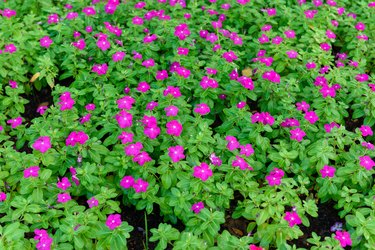
Three plants are known as vincas. The name is just about the only thing the two different species have in common: Two are perennial ground covers for shade and the other is a frost-tender perennial grown as mounding annual for sun. Despite the confusing name, it's not hard to tell the two species apart.
Annual Vinca Plants
Video of the Day
Commonly known as annual vincas (Catharanthus roseus), periwinkle or Madagascar periwinkle, these heat-loving, tender perennials are often used as annual bedding plants in full sun. These plants are only hardy in frost-free areas of U.S. Department of Agriculture plant hardiness zones 9b through 11. There are many different types or "series" of vinca available, in heights from 6 to 18 inches. Most annual vincas are white or shades of pink or lilac; there are no true blue or yellow varieties available.
Video of the Day
Annual Vinca Culture
Grow annual vincas in full sun or very light shade, as they will not flower well without at least six hours of direct sunlight. Space the plants 8 to 10 inches apart and fertilize them lightly when you first install them. They'll need supplemental watering for the first two or three weeks, but once established, annual vincas are drought-tolerant and need watering only during extended dry spells.
The plants are self-cleaning and don't need deadheading. While they're perennials in the warmest climates, annual vincas are sensitive to cold and will be ruined by even a light frost.
Perennial Vinca Flowers
Common periwinkle or creeping myrtle (Vinca minor) is a 6-inch, creeping perennial ground cover for partial to full shade in USDA zones 4 through 9. This fine-textured evergreen spreads at a medium rate and is often used under shrubs and trees, as it doesn't climb up into the larger plants like ivy will. Periwinkle has a big flush of blue, purple or white flowers in spring, followed by sporadic flowering throughout the rest of the season. Both white-and-green and yellow-and-green variegated cultivars are available.
Periwinkle's big cousin (Vinca major) is known as big, bigleaf, large or greater periwinkle. It grows up to 12 inches high, with larger leaves and flowers, and while it also spreads, it makes a more mounding or undulating ground cover than V. minor.
Bigleaf periwinkle is most commonly seen in the South, as it's hardy in USDA zones 6 through 9, where it may suffer die-back during harsh winters. The variegated forms of bigleaf periwinkle are also sold in individual pots as trailing plants for large, mixed container gardens.
Perennial Vinca Culture
Both Vinca minor and V. major have the same growing conditions. Plant them in partial to full shade in moist, well-draining soil in areas where they can spread out. They're good choices for under-planting shrubs and trees, as a lawn substitute in shady spots and for controlling erosion on slopes. If they suffer leaf burn during the winter, give them a haircut with your mower set on its highest setting.
Both of the perennial vinca species are considered invasive. Common vinca has escaped cultivation along the East Coast, while bigleaf vinca threatens habitats on the West Coast. Use caution when planting these rapidly spreading grown covers.